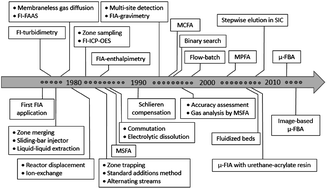Flow analysis in Brazil: contributions over the last four decades
Abstract
The main contributions of Brazilian researchers to the field of flow analysis are reviewed, with an emphasis on historical developments, conceptual aspects, system design, and analytical applications. Contributions after the advent of flow injection analysis are highlighted. Novel approaches (e.g. zone merging, zone sampling, zone trapping, multi-site detection, and multi-commutation), flow modalities (e.g. monosegmented flow analysis, flow-batch analysis, multi-pumping flow analysis), as well as the pioneering implementation of different detection techniques (e.g. potentiometry, turbidimetry, flame atomic absorption spectrometry, inductively coupled plasma-optical emission spectrometry, and gravimetry) and analytical steps (e.g. titrations, membrane-less gas diffusion, and electrolytic dissolution) are highlighted. Strategies to improve analytical figures of merit and the use of the flow analyser as a tool for teaching purposes are also discussed. Contributions from Brazilian workers in the context of system miniaturization, “green” chemistry, analysis of complex samples, novel strategies and materials for in-line analyte separation/concentration, and proposals for expert systems are also highlighted. The large-scale analysis of samples of agronomical, environmental, industrial, and clinical relevance is emphasized.

- This article is part of the themed collection: Analytical Sciences in Brazil

 Please wait while we load your content...
Please wait while we load your content...